.
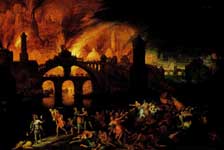
Pieter Schoubroeck, Burning Troy, 1570/1607
Troy (Greek: Τροία Troia (or CMC Τροίη) also Ἴλιον Ílion; see also List of traditional Greek place names; Latin: Troia, Ilium) is a legendary city, scene of the Trojan War, part of which is described in Homer's Iliad, an epic poem in Ancient Greek, composed in the 9th or 8th century BC, but containing older material (Iliad means "about Ilion").
Troy (Turkish: Truva) is also the name of an archaeological site, the traditional location of Homeric Troy, in Asia Minor or Anatolia, close to the seacoast in what is now northwest Turkey, southwest of the Dardanelles under Mount Ida.
A new city of Ilium was founded on the site that many believed to be the location of the legendary Ilion in the reign of the Roman Emperor Augustus. It flourished until the establishment of Constantinople, and declined gradually during Byzantine times. The Roman city of Celeia (now Celje in Slovenia) has been referred to by some writers as Troia secunda ("the second Troy").
In the 1870s the German archaeologist Heinrich Schliemann excavated the area. Later excavations revealed several cities built in succession to one another. One of the earlier cities (Troy VIIa) is often identified with Homeric Troy. While such an identity is disputed, the site has been successfully identified with the city called Wilusa in Hittite texts; Ilion (which goes back to earlier Wilion with a digamma) is thought to be the Greek rendition of that name.


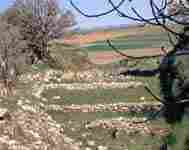
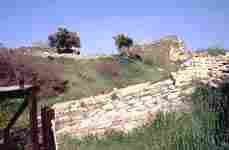
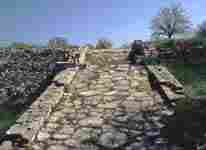


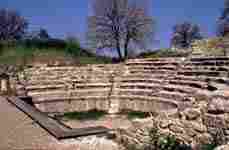

The Legend
The story of the Trojans first began in myth and legend. According to Greek mythology, the Trojans (or Troyans, or Dardani) were the ancient citizens of the city of Troy in the Troad area, in the country of Phrygia, in the land of Asia Minor (or Little Asia, now Turkey). Troy was known for its riches, gained from port trade with east and west, fancy clothes, iron production, and massive defensive walls. The Trojan royal family was started by Elektra and Zeus, the parents of Dardanus. Elektra raised Dardanus in her palace on the island of Samothrace. King Tros called the people Trojans and the land Troad, after himself. Ilus founded the city of Ilium that he called after himself. Zeus gave Ilus the Palladium. Poseidon and Apollo built the walls and fortifications around Troy for Laomedon, son of Ilus the younger. When Laomedon refused to pay, Poseidon flooded the land and demanded the sacrifice of Hesione to a sea monster. Pestilence came and the sea monster snatched away the people of the plain.
One generation before the Trojan War, Heracles captured Troy and killed Laomedon and his sons, except for young Priam. Priam later became king. During his reign, the Mycenaean Greeks invaded and captured Troy in the Trojan War (traditionally dated to 1193 BC-1183 BC). Both the Trojans and Mycenaean cultures were destroyed in the war. The Trojans Aeneas, Brutus, and Elymus escaped the destruction and became founders of Alba Longa (Rome), Britain, and the Elymi, a people of Sicily. The Maxyans were a west Libyan tribe who said that they were descended from the men of Troy, according to Herodotus. The Trojan ships transformed into naiads, who rejoiced to see the wreckage of Odysseus' ship.
Trojan rule in Asia Minor was replaced by the "sons of Herakles" dynasty in Sardis that ruled for 505 years until the time of Candaules. The Ionians, Cimmerians, Phrygians, Milesians of Sinope, and Lydians moved into Asia Minor. The Persians invaded in 546 BC.
Some famous Trojans are: Dardanus (founder of Troy), Laomedon, Ganymede, Priam, Paris, Hector, Teucer, Aesacus, Oenone, Telamon, Tithonus, Antigone, Memnon, Corythus, Aeneas, Brutus, and Elymus. Kapys, Boukolion, Aesacus, and Paris were Trojan princes who had naias wives. Some of the Trojan allies were the Hittites and the Amazons. The Aisepid nymphs were the naiads of the Trojan River Aisepos. Pegsis was the naiad of the River Grenikos near Troy.
A Trojan law mentioned by E.O. Gordon allowed queens as well as kings. This law was adopted by King Dunvallo Molmutius (from Brutus) in his code and is still in effect today in Britain.
Mount Ida ("Mount of the Goddess") in Asia Minor, is where Ganymede was abducted by Zeus, where Anchises was seduced by Aphrodite, where Aphrodite gave birth to Aeneas, where Paris lived as a shepherd, where the nymphs lived, where the "Judgement of Paris" took place, where the Greek gods watched the Trojan War, where Hera distracted Zeus with her seductions long enough to permit the taking of Troy, and where Aeneas and his followers rested and waited until the Greeks set out for Greece. The altar of Panomphaean (‘source of all oracles’) was dedicated to Jupiter the Thunderer (Tonatus) near Troy. Buthrotos (or Buthrotum) was a city in Epirus where Helenus, the Trojan seer, built a replica of Troy. Aeneas landed there and Helenus foretold his future.
Homeric Troy
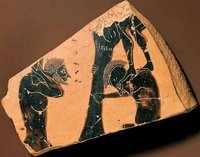
Soldiers climbing out of the Trojan Horse (fragment, ca. 550 BC)
In the Iliad, the Achaeans set up their camp near the mouth of the river Scamander (modern Karamenderes), where they had beached their ships. The city of Troy itself stood on a hill, across the plain of Scamander, where the battles of the Trojan War took place. The site of the ancient city today is some 15 kilometers from the coast, but the ancient mouths of Scamander, some 3,000 years ago, were some 5 kilometers further inland, pouring into a bay that has since been filled with alluvial material.
Besides the Iliad, there are references to Troy in the other major work attributed to Homer, the Odyssey, as well as in other ancient Greek writings. The Homeric legend of Troy was elaborated by the Roman poet Virgil in his work the Aeneid. The Greeks and Romans took for a fact the historicity of the Trojan War, and in the identity of Homeric Troy with the site in Anatolia. Alexander the Great, for example, visited the site in 334 BC and made sacrifices at the alleged tombs of the Homeric heroes Achilles and Patroclus.
Ancient Greek historians placed the Trojan War variously in the 12th, 13th or 14th century BC: Eratosthenes to 1184 BC, Herodotus to 1250 BC, Douris to 1334 BC.
In November 2001, geologists John C. Kraft from the University of Delaware and John V. Luce from Trinity College, Dublin presented the results (see [1], [2], & [3]) of investigations into the geology of the region that had started in 1977. The geologists compared the present geology with the landscapes and coastal features described in the Iliad and other classical sources, notably Strabo's Geographia. Their conclusion was that there is regularly a consistency between the location of Troy as identified by Schliemann (and other locations such as the Greek camp), the geological evidence, and descriptions of the topology and accounts of the battle in the Iliad.
There is, however, a recent theory proposed by historian Iman Wilkins that proposes a new location of Troy in England. The theory is generally not accepted by classicists.
Professor Felipe Vinci has set forth another theory,[4], locating Troy in southern Finland and identifying all the besiegers and besieged around the Baltic Sea. His theory holds that the Trojan War happened many centuries earlier than generally believed, just before the Greeks were forced by a change in climate to migrate south to the Mediterranean.
Dr. Immanuel Velikovsky, while accepting the traditional geography of the Trojan War, argued [ 5 ] that the Greek Dark Ages never happened, and that the Trojan War was fought several centuries later than is now generally believed.
Archaeological Troy
The layers of ruins on the site are numbered Troy I – Troy IX, with various subdivisions:
- Troy I – Troy IV: early Bronze Age (3rd millennium BC)
- Troy V: 20th – 18th centuries BC.
- Troy VI: 17th – 15th centuries BC.
- Troy VIh: late Bronze Age, 14th century BC
- Troy VIIa: ca. 1300 – 1190 BC, most likely candidate for Homeric Troy.
- Troy VIIb1: 12th century BC
- Troy VIIb2: 11th century BC
- Troy VIIb3: until ca. 950 BC
- Troy VIII: around 700 BC
- Troy IX: Hellenistic Ilium, 1st century BC
Troy I–V
The first city was founded in the 3rd millennium BC. During the Bronze Age, the site seems to have been a flourishing mercantile city, since its location allowed for complete control of the Dardanelles, through which every merchant ship from the Aegean Sea heading for the Black Sea had to pass.
Troy VI
Troy VI was destroyed around 1300 BC, probably by an earthquake. Only a single arrowhead was found in this layer, and no bodily remains.
Troy VII
The archaeological layer known as Troy VIIa, which has been dated on the basis of pottery styles to the mid- to late-13th century BC, is the most often-cited candidate for the Troy of Homer. It appears to have been destroyed by a war, and there are traces of a fire. Until the 1988 excavations, the problem was that Troy VII seemed to be a hill-top fort, and not a city of the size described by Homer, but later identification of parts of the city ramparts suggests a city of considerable size.
Partial human remains were found in houses and in the streets, and near the north-western ramparts a human skeleton with skull injuries and a broken jawbone. Three bronze arrowheads were found, two in the fort and one in the city. However, only small portions of the city have been excavated, and the finds are too scarce to clearly favour destruction by war over a natural disaster.
Troy VIIb1 (ca. 1120 BC) and Troy VIIb2 (ca. 1020 BC) appear to have been destroyed by fires.
Troy IX
The last city on this site, Hellenistic Ilium, was founded by Romans during the reign of the emperor Augustus and was an important trading city until the establishment of Constantinople in the fourth century as the eastern capital of the Roman Empire. In Byzantine times the city declined gradually, and eventually disappeared.
Excavation campaigns
Schliemann

Aeneas with Anchises and his son, "Georg Ludwig Jerrers, Weltgeschichte für Kinder (Nürnberg 1828)", after a work of Johann Michael Voltz (1784-1858). According to H. Schliemann it was this image in a children book that inspired him to search Troy. His father said that nothing remained from Troy reading the story but Schliemann could not imagine that nothing remained from the strong walls of Troy
With the rise of modern critical history, Troy and the Trojan War were consigned to the realms of legend. In the 1870s (in two campaigns, 1871-73 and 1878/9), however, the German archaeologist Heinrich Schliemann excavated a hill, called Hissarlik by the Turks, near the town of Chanak (Çanakkale) in north-western Anatolia. Here he discovered the ruins of a series of ancient cities, dating from the Bronze Age to the Roman period. Schliemann declared one of these cities—at first Troy I, later Troy II—to be the city of Troy, and this identification was widely accepted at that time.
Dörpfeld, Blegen
After Schliemann, the site was further excavated under the direction of Wilhelm Dörpfeld (1893/4) and later Carl Blegen (1932-8). These excavations have shown that were at least nine cities built one on top of each other at this site.
Korfmann
In 1988 excavations were resumed by a team of the University of Tübingen and the University of Cincinnati under the direction of Professor Manfred Korfmann. The question of Troy's status in the Bronze Age world has been the subject of a sometimes acerbic debate between Korfmann and the Tübingen historian Frank Kolb in 2001/2002.
In August 2003 following a magnetic imaging survey of the fields below the fort, a deep ditch was located and excavated among the ruins of a later Greek and Roman city. Remains found in the ditch were dated to the late Bronze Age, the alleged time of Homeric Troy. It is claimed by Korfmann that the ditch may have once have marked the outer defences of a much larger city than had previously been suspected.
Possible evidence of a battle was also found in the form of arrowheads found in layers dated to the early 12th century BC.
Korfmann died on 11 August 2005, and since the digging permit was tied to his person, it is uncertain how and when the excavations will continue.
Hittite evidence
In the 1920s the Swiss scholar Emil Forrer claimed that placenames found in Hittite texts — Wilusa and Taruisa — should be identified with Ilium and Troia respectively. He further noted that the name of Alaksandus, king of Wilusa, mentioned in one of the Hittite texts is quite similar to the name of Prince Alexandros or Paris of Troy.
The Hittite king Mursili II in ca. 1320 BC wrote a letter to the king of the Ahhiyawa, treating him as an equal and implying that Miletus (Millawanda) was controlled by the Ahhiyawa, and also referring to an earlier "Wilusa episode" involving hostility on the part of the Ahhiyawa. This people has been identified with the Homeric Greeks (Achaeans).
These identifications were rejected by many scholars as being improbable or at least unprovable. Trevor Bryce in 1998 championed them in his book The Kingdom of the Hittites, citing a recovered piece of the so-called Manapa-Tarhunda letter, which refers to the kingdom of Wilusa as beyond the land of the Seha (known in classical times as the Caicus) river, and near the land of Lazpa (the Isle of Lesbos).
Recent evidence adds weight to the theory that Wilusa is identical to archaeological Troy. Hittite texts mention a water tunnel at Wilusa, and a water tunnel excavated by Korfmann, previously thought to be Roman, has been dated to around 2600 BC.
The identifications of Wilusa with archaeological Troy and of the Achaeans with the Ahhiyawa remains controversial, but gained enough popularity during the 1990s to be considered a majority opinion.
Homeric Ilion and historical Wilusa
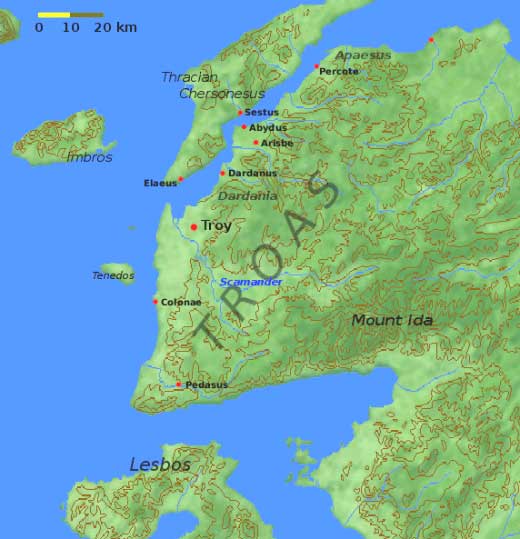
Map of the Troas
The events described in Homer's Iliad, even if based on historical events that preceded its composition by some 450 years, will never be completely identifiable with historical or archaeological facts, even if there was a Bronze Age city on the site now called Troy, and even if that city was destroyed by fire or war at about the same time as the time postulated for the Trojan War.
No text or artifact has been found on site itself which clearly identifies the Bronze Age site. This is probably due to the planification of the former hillfort during the construction of Hellenistic Ilium (Troy IX), destroying the parts that most likely contained the city archives. A single seal of a Luwian scribe has been found in one of the houses, proving the presence of written correspondence in the city, but not a single text. Our emerging understanding of the geography of the Hittite Empire makes it very likely that the site corresponds to the city of Wilusa. But even if that is accepted, it is of course no positive proof of identity with Homeric (W)ilion.
A name Wilion or Troia does not appear in any of the Greek written records from the Mycenean sites. The Mycenaean Greeks of the 13th century BC had colonized the Greek mainland and Crete, and were only beginning to make forays into Anatolia, establishing a bridgehead in Miletus (Millawanda). Historical Wilusa was one of the Arzawa lands, in loose alliance with the Hittite Empire, and written reference to the city is therefore to be expected in Hittite correspondence rather than in Mycenaean palace archives.
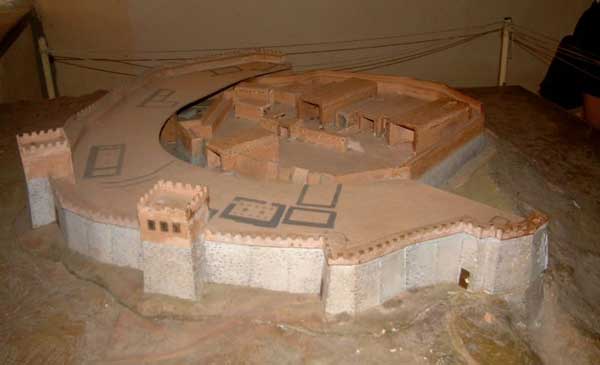
Reconstruction of Troy (Source)
Status of the Iliad
The dispute over the historicity of the Iliad was very heated at times. The more we know about Bronze Age history, the clearer it becomes that it is not a yes-or-no question but one of educated assessment of how much historical knowledge is present in Homer. The story of the Iliad is not an account of the war, but a tale of the psychology, the wrath, vengence and death of individual heroes that assumes common knowledge of the Trojan War to create a backdrop. No scholars assume that the individual events in the tale (many of which centrally involve divine intervention) are historical fact; on the other hand, no scholars claim that the scenery is entirely devoid of memories of Mycenaean times: it is rather a subjective question of whether the factual content is rather more or rather less than one would have expected. The ostensible historicity of Homer's Troy faces the same hurdles as with Plato's Atlantis. In both cases, an ancient writer's story is now seen by some to be true, by others to be mythology or fiction. It may be possible to establish connections between either story and real places and events, but these always risk to be subject to selection bias.
The Iliad as essentially legendary
Some archaeologists and historians maintain that none of the events in Homer are historical. Others accept that there may be a foundation of historical events in the Homeric stories, but say that in the absence of independent evidence it is not possible to separate fact from myth in the stories.
In recent years scholars have suggested that the Homeric stories represented a synthesis of many old Greek stories of various Bronze Age sieges and expeditions, fused together in the Greek memory during the "dark ages" which followed the fall of the Mycenean civilization. In this view, no historical city of Troy existed anywhere: the name derives from a people called the Troies, who probably lived in central Greece. The identification of the hill at Hissarlik as Troy is, in this view, a late development, following the Greek colonisation of Asia Minor in the 8th century BC.
The Iliad as essentially historical
Another view is that Homer was heir to an unbroken tradition of epic poetry reaching back some 500 years into Mycenaean times. In this view, the poem's core could reflect a historical campaign that took place at the eve of the decline of the Mycenaean civilization. Much legendary material would have been added during this time, but in this view it is meaningful to ask for archaeological and textual evidence corresponding to events referred to in the Iliad. Such a historical background gives a credible explanation for the geographical knowledge of Troy (which could, however, also have been obtained in Homer's time by visiting the traditional site of the city) and otherwise unmotivated elements in the poem (in particular the detailed Catalogue of Ships). Linguistically, a few verses of the Iliad suggest great antiquity, because they only fit the meter if projected back into Mycenaean Greek, suggesting a poetic tradition spanning the Greek Dark Ages. Even though Homer was Ionian, the Iliad reflects the geography known to the Mycenaean Greeks, showing detailed knowledge of the mainland but not extending to the Ionian islands or Anatolia, which suggests that the Iliad reproduces an account of events handed down by tradition, to which the author did not add his own geographical knowledge.
Tourism
Today there is a Turkish town called Truva in the vicinity of the archaeological site, but this town has grown up recently to service the tourist trade. The archaeological site is officially called Troy by the Turkish government and appears as such on many maps.
A large number of tourists visit the site each year, mostly coming from Istanbul by bus or by ferry via Çanakkale. The visitor sees a highly commercialised site, with a large wooden horse built as a playground for children, then shops and a museum. The archaeological site itself is, as a recent writer said, "a ruin of a ruin," because the site has been frequently excavated, and because Schliemann's archaeological methods were very destructive: in his conviction that the city of Priam would be found in the earliest layers, he demolished many interesting structures from later eras, including all of the house walls from Troy II. For many years also the site was unguarded and was thoroughly looted.
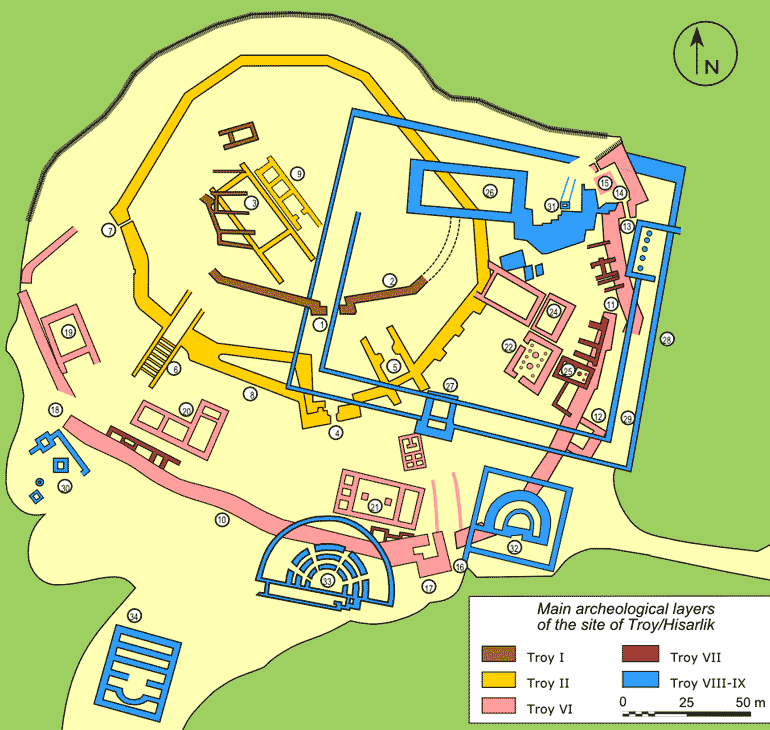
Plan of the archeological site of Troy/Hisarlik, Source. Bibi Saint-Pol
Legend:
- 1: Gate
- 2: City Wall
- 3: Megarons
- 4: FN Gate
- 5: FO Gate
- 6: FM Gate and Ramp
- 7: FJ Gate
- 8: City Wall
- 9: Megarons
- 10: City Wall
- 11: VI. S Gate
- 12: VI. H Tower
- 13: VI. R Gate
- 14: VI. G Tower
- 15: Well-Cistern
- 16: VI. T Dardanos Gate
- 17: VI. I Tower
- 18: VI. U Gate
- 19: VI. A House
- 20: VI. M Palace-Storage House
- 21: Pillar House
- 22: VI. F House with columns
- 23: VI. C House
- 24: VI. E House
- 25: VII. Storage
- 26: Temple of Athena
- 27: Entrance to the Temple (Propylaeum)
- 28: Outer Court Wall
- 29: Inner Court Wall
- 30: Holy Place
- 31: Water Work
- 32: Parliament (Bouleuterion)
- 33: Odeon
Troy in later legend
see also Trojan War.
Such was the fame of the Trojan story in Roman and medieval times that it was built upon to provide a starting point for various legends of national origin. The most famous is undoubtedly that promulgated by Virgil in the Aeneid, tracing the ancestry of the founders of Rome, and more specifically the Julio-Claudian dynasty, to the Trojan prince Aeneas. Similarly Geoffrey of Monmouth traces the legendary kings of Britain to a supposed descendant of Aeneas called Brutus.
Troy c. 1700-1250 BC, Nic Fields, Donato Spedaliere, Sarah Sulemsohn Spedaliere
Related articles
- Bronze Age
- Heinrich Schliemann
- Mycenae
- Trojan War
- Homer
- Iliad
- Trojan horse
Links
- Archaeology
- Project Troia - The new excavations at Troy
- digital reconstructions of the city
- Troy VII and the Historicity of the Trojan War
- Where Is "Troy" Now?
- Ilios. The city and country of the Trojans: the results of researches and discoveries on the site of Troy and through the Troad in the years 1871-72-73-78-79; (searchable facsimile at the University of Georgia Libraries, requires dejavu-plugin)
- Project Troia - The new excavations at Troy
- Geography
- the Troad (with an image of a model of Troy II)
- Geomorphologic changes in the valley of the Scamander (link broken as of 23 Aug 2005)
- Alternative location theories
- The Trojan Kings of England
In Search of the Trojan War
| Ancient Greece
Science, Technology , Medicine , Warfare, , Biographies , Life , Cities/Places/Maps , Arts , Literature , Philosophy ,Olympics, Mythology , History , Images Medieval Greece / Byzantine Empire Science, Technology, Arts, , Warfare , Literature, Biographies, Icons, History Modern Greece Cities, Islands, Regions, Fauna/Flora ,Biographies , History , Warfare, Science/Technology, Literature, Music , Arts , Film/Actors , Sport , Fashion --- |
Retrieved from "http://en.wikipedia.org/"
All text is available under the terms of the GNU Free Documentation License
